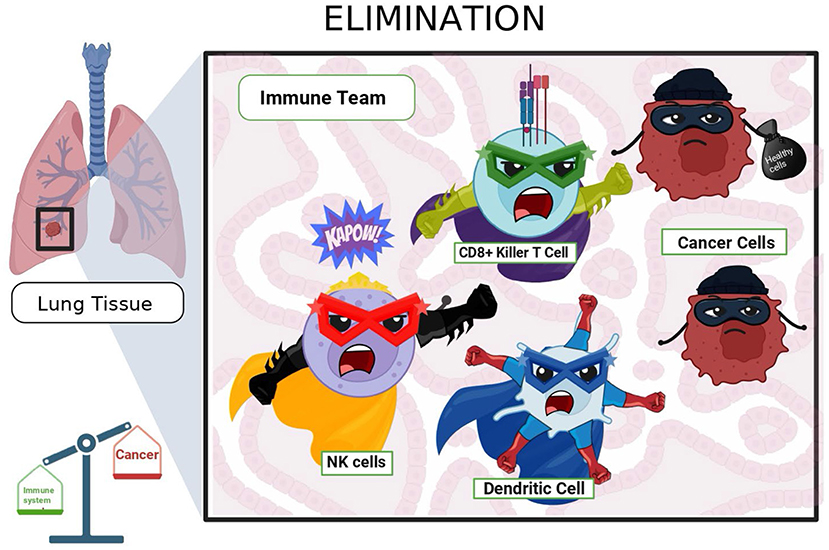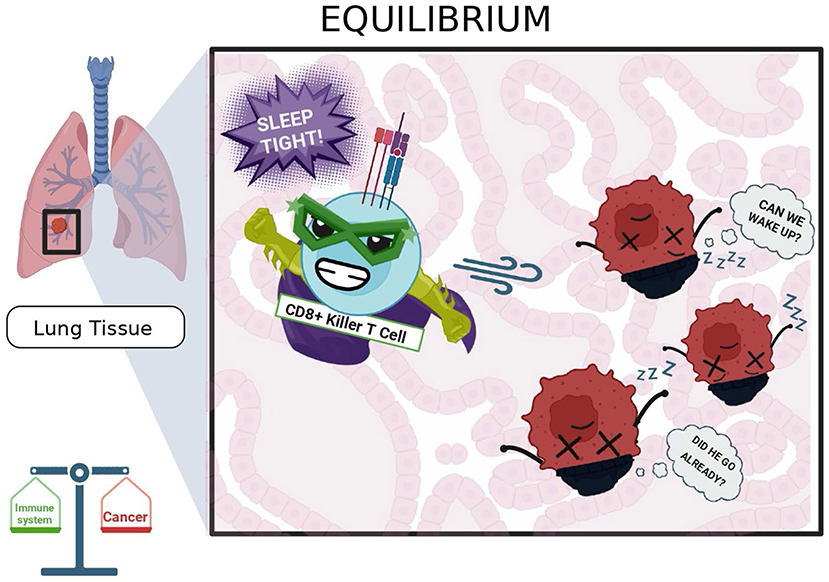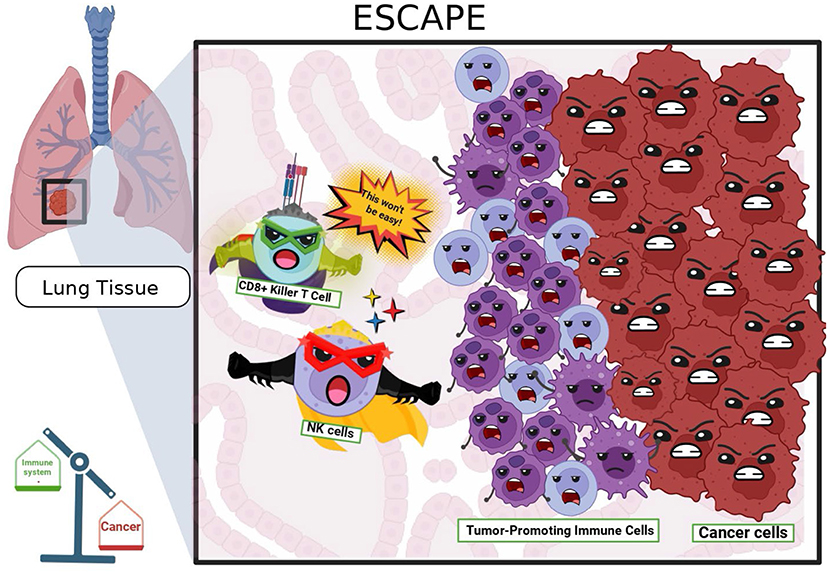Abstract
Did you know that your immune system is like a superhero team that can eliminate cancer cells before they are even detectable? Cancer starts when changes occur in the DNA of normal cells, causing them to turn into cancerous cells. Luckily, the body’s defense team—the immune system—is designed to detect these changes and fight the cancer cells. But why do people still get cancer? Scientists have developed a theory that explains this fight through three key phases: elimination, equilibrium, and escape. In the elimination phase, the immune system, like a vigilant hero, gets rid of most of the tumor cells. The cells that survive enter a sleep-like state called equilibrium. Eventually, these cells can wake up and use clever tactics to evade the immune system, moving into the escape phase. Understanding this process can help researchers develop new treatments to better combat cancer.
The Body’s Secret Superheroes: How Cells Grow, Change, and Fight Back
In the complex universe of the human body, trillions of cells are like dedicated workers, each performing unique tasks. At the heart of each cell lies a set of genetic instructions—a master plan for growth, division, and survival directed by the cell cycle’s two main stages: the growth phase and the division phase. During this mission, cells grow, duplicate their genetic instructions, and prepare for division, with control points along the way, ensuring everything proceeds smoothly. However, the process is not always flawless. Sometimes, once-healthy cells can change or transform. A single change in a cell does pose a significant threat to the body, but when a cell accumulates numerous changes, it can begin to grow uncontrollably, invading nearby territories and eventually forming detectable lumps, called tumors.
Cancer is a leading cause of death worldwide and can appear in over a hundred different forms, affecting people everywhere, of all different backgrounds. Cancer arises when cells grow uncontrollably in one region of the body, forming a tumor. In advanced stages, cancer can spread throughout the body, which is called metastasis. To combat this adversary, scientists and medical doctors use various strategies, including chemicals called chemotherapy designed to attack cancer cells, radiation to destroy them, and therapies to help the immune system fight back. Often, a combination of these techniques is used, tailored to the specific type and stage of the cancerous threat.
The immune system is like a team of superheroes, always on alert to keep us healthy. These superheroes protect us from the “bad guys” that can make us sick, including germs like bacteria, viruses, fungi, and parasites. The immune system has two main squads: one that acts like a team of first responders, jumping into action quickly to stop any germs that sneak into our bodies. When the situation gets tougher, the second squad steps in, using its flexible abilities to provide a highly specialized and powerful defense, tailored to specific threats. And here is something really cool: the immune system superheroes also fight cancer, just like they fight germs.
The 3 E’s of Cancer Defense
The immune system’s fight against cancer happens in three phases, known as the 3 E’s: elimination (getting rid of cancer cells), equilibrium (when cancer cells are kept in check), and escape (when cancer cells avoid detection and elimination). This is like a battle in which our immune system superheroes either protect us from cancer or accidentally allow the dangerous cells to become stronger. During the equilibrium phase, the immune system keeps the cancer cells under control, but if they manage to escape, they can spread to other parts of the body. Sometimes, the immune system eliminates cancer cells without us even knowing, or it might keep the cells under control in the equilibrium phase for our whole lives. However, there are times when the elimination phase is not enough, and the cancer cells change during equilibrium, eventually leading them to spread and evade the immune system in the escape phase.
Elimination Phase: Getting Rid of Cancer Cells
During the elimination phase, an elite team of immune cells patrols the body, searching for and destroying dangerous cancer cells before they can form tumors (Figure 1) [1]. The cancer cells have changed in ways that make them stand out, and these unique features are detected by the immune system as part of its surveillance role. Several types of “first responder” cells excel at fighting cancer cells. For example, natural killer (NK) cells are especially skilled at detecting transformed cells by spotting features that are missing compared to normal cells, triggering a process that causes the transformed cells to self-destruct.

- Figure 1 - During the elimination phase of lung cancer, immune system superheroes such as NK cells, CD8+ killer T cells, and dendritic cells join forces to fight transformed cells before they become a tumor.
- This can happen even without the person noticing the battle going on inside them. The scale in the lower left shows the immune system gaining the upper hand, tipping the balance in its favor as these powerful defenders successfully eliminate cancer cells.
Meanwhile, cells called dendritic cells (DCs) act as the captains of this elite superhero team, showing “wanted posters” of the transformed cell to other cells of the immune system, including the strongest fighters, called CD8+ killer T cells, which can take down transformed cells with powerful precision. Together, the cells of the immune system work to wipe out the dangerous cancer cells and win the battle. If they successfully eliminate all the transformed cells, the process ends, and the body stays tumor-free.
Equilibrium Phase: Cancer Cells Playing Dead
If the villain cells survive the initial battle, they enter a state of calm in which they “play dead”. During this phase, there is no visible tumor growth thanks to continued surveillance—the immune system keeps these sleeping cells in check, preventing them from causing trouble. However, these “playing dead” villain cells can still undergo changes over time, like sneaky upgrades, which might help them start multiplying, growing, and avoiding detection later on [2].
While in the equilibrium phase, the cancer cells are like quiet threats, waiting for the right moment to awaken and form a detectable tumor, which can progress to the stage where the cancer spreads to other parts of the body. Once the conditions become favorable for them, these dangerous cells can resume their growth and spread throughout the body. This phase might be the longest part of the battle—it can last throughout the patient’s life, often without them even knowing (Figure 2).

- Figure 2 - During the equilibrium stage of lung cancer, some cancer cells may remain, but the immune system prevents them from growing.
- During this time, the cancer cells appear dormant, like they are “playing dead”, while they are actually undergoing changes that can eventually lead to the escape phase. The equilibrium phase maintains a delicate balance between the cancer and the immune system, as illustrated by the scale in the lower left.
Escape Phase: Avoiding Detection by the Immune System
In the escape phase, some of the “sleeping” cancer cells wake up and become powerful enough to dodge the body’s immune system. When cancer is diagnosed, it is often during this tricky phase. The reawakened tumor cells create a challenging environment for the immune system, with the help of their allies—tumor-promoting immune cells. These traitorous cells help the tumor grow by weakening the immune system disabling the body’s cancer-fighting superheroes, making them less effective. For example, some cells that come from the bone marrow can turn T cells from strong defenders into tumor helpers. Tumor-promoting macrophages work against NK cells and T cells, allowing the cancer to spread and invade other organs [3].
These tumor-promoting immune cells create a perfect hideout for the tumor, full of nutrients and protection. This “tumor area” is like a well-fortified fortress where the cancer cells and their allies set up camp, making it harder for the immune system to fight back. The conditions in the tumor area influence how the cancer develops and spreads, leading to more aggressive tumors and tougher battles for treatment. Now, CD8+ T killer cells and NK cells face a vast army of cancer cells surrounded by traitorous immune-suppressing cells (Figure 3).

- Figure 3 - During the escape phase, the cancer cells that were “playing dead” begin to divide uncontrollably and start clumping together to form a detectable tumor.
- They do this by escaping the powers of the immune system. During this phase, tumor-promoting immune cells are produced by the body, making it more difficult for the immune system to fight the cancer cells. As shown by the scale in the lower left, at this stage the balance shifts in favor of the cancer cells.
The Battle Continues: How Immunotherapy Might Turn the Tide Against Cancer
In the ongoing battle against cancer, our bodies work hard to fix and protect themselves. Just like a superhero keeps an eye on the city, our immune system is always on the lookout, getting rid of dangerous cells before they become big problems. If some cells survive this first attack, they go into a “sleeping mode”, waiting for a better time to come back. When these tricky cells wake up, they find ways to hide from the immune system, sometimes by tricking the immune system into helping them—by turning some immune cells into traitors that support tumor growth and spread.
Doctors and scientists are working hard to come up with new treatments to fight these threats. One promising treatment is called immunotherapy, in which the immune system is boosted or trained to recognize and destroy cancer cells more effectively. Hopefully, one day, immunotherapy treatments will help cure or prolong the lives of many people who are battling cancer, offering new hope for those affected by this challenging disease.
Glossary
Tumor: ↑ A mass of abnormal cells that grow uncontrollably. Tumors can be benign (non-cancerous) or malignant (cancerous).
Cancer: ↑ A disease characterized by uncontrolled cell growth in a region of the body that becomes a tumor and can spread to other areas of the body in later stages.
Metastasis: ↑ The process by which cancer cells spread from their original site to other parts of the body, forming new tumors. This spread can occur through the bloodstream.
Immune System: ↑ The body’s defense system made up of various cells that protect against infections, diseases, and transformed cells, including cancer.
Elimination: ↑ The process by which the immune system successfully detects and destroys cancer cells, preventing their growth or spread.
Equilibrium: ↑ A state in which the immune system and cancer cells are in balance, preventing tumor growth without fully eliminating the cancer.
Escape: ↑ The phase in which cancer cells evade the immune system, growing uncontrollably despite immune defenses.
Conflict of Interest
The authors declare that the research was conducted in the absence of any commercial or financial relationships that could be construed as a potential conflict of interest.
Acknowledgments
This research was supported by the PR IDeA Network for Biomedical Excellence (NIH NIGMS: P20-GM103475), the Puerto Rico Louis Stokes Alliance for Minority Participation (NSF: HRD-2008186), and the Botanic Institute of Para la Naturaleza at the University of Puerto Rico (UPR) in Humacao. Special thanks to all the members of the Advancing Cancer Immunology & Science Communication Research Lab at the UPR in Humacao.
AI Tool Statement
The author(s) declare that Gen AI was used in the creation of this manuscript. The authors used artificial intelligence (ChatGPT-4o) for syntax, clarity, and vocabulary. Images created with BioRender.com.
Any alternative text (alt text) provided alongside figures in this article has been generated by Frontiers with the support of artificial intelligence and reasonable efforts have been made to ensure accuracy, including review by the authors wherever possible. If you identify any issues, please contact us.
References
[1] ↑ Dunn, G. P., Old, L. J., and Schreiber, R. D. 2004. The three Es of cancer immunoediting. Ann. Rev. Immunol. 22:329–60. doi: 10.1146/annurev.immunol.22.01270
[2] ↑ Schreiber, R. D., Old, L. J., and Smyth, M. J. 2011. Cancer immunoediting: integrating immunity’s roles in cancer suppression and promotion. Science 331:1565–70. doi: 10.1126/science.1203486
[3] ↑ Mittal, D., Gubin, M. M., Schreiber, R. D., and Smyth, M. J. 2014. New insights into cancer immunoediting and its three component phases–elimination, equilibrium and escape. Curr. Opin. Immunol. 27:16–25. doi: 10.1016/j.coi.2014.01.004
